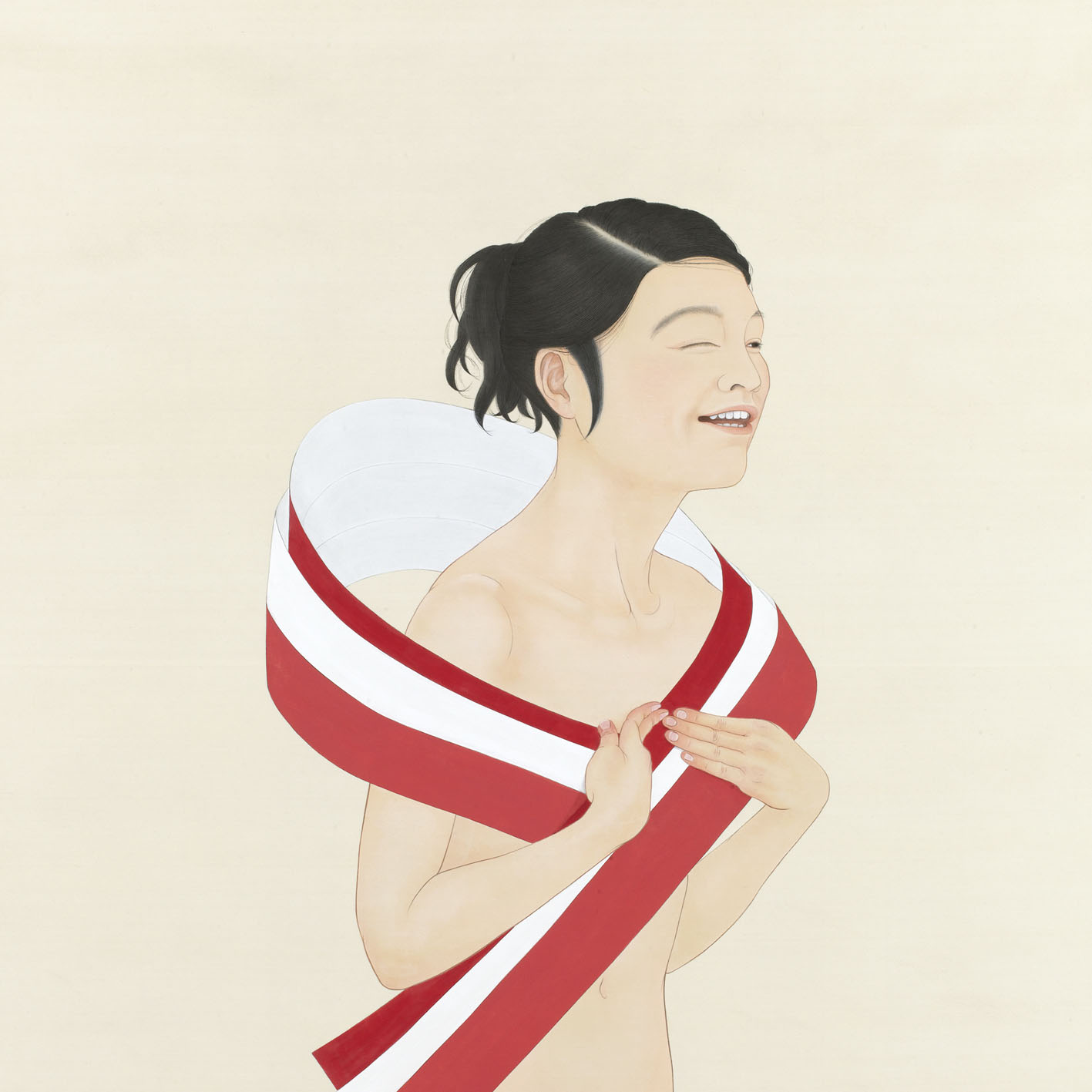"Tradition," and how one might relate to it, is often met with censure in contemporary art. It implies inheritance and repetition and is occasionally thought of as uncreative. None of this has to be true, but the tension between the tradition of nihonga (Japanese-style painting) and the desire to be contemporary is evident in "Kaori Watanabe: Good News of the Morning" at Kyoto's imura art gallery.
Watanabe does not consider her artistic production as limited to nihonga and she views her recent work as a departure from it. While she does not yearn for the traditional subjects of the genre, instead pursuing ones of a contemporary calling, her artistic materials (mineral pigments on silk) and techniques have been honed through emulating past masters. For the artist, however, perpetuating the past carries little meaning, and this is all the more intriguing given she had earlier reproduced the past so assiduously.
Watanabe trained at Kyoto Saga University of Arts and her early work followed her artistic forbears', reproducing them in minute detail and using their techniques. She made copies of paintings by the Rimpa artist Sakai Hoiitsu (1761-1828) in 2005 and similarly reproduced portions of the "Scroll of Frolicking Animals" attributed to Toba Sojo (1053-1140) as well as some of the more recent Buddhist works by the nihonga painter Hayashi Shime (1906-1985).
In 2007, she donated her reproduction of a Tosa Mitsuoki (1617-1691) painting of the renowned courtesan Yoshino-dayuu to Josho-ji Temple in Kyoto. The painting is deeply immersed in the past, depicting the kind of curvaceous feminine beauty that became popular in the late 17th century with the rise of the pleasure quarters.
Watanabe's fastidious attention to historical detail has also taken her in filmic directions, collaborating on the movie "Sakuran" (2006), directed by Mika Ninagawa, and the TV drama "Damashie Utamaro" (2009).
Her present work finds its origins in those earlier years. In 2004, Watanabe painted "Crab Ceremony," a mildly Surrealist work in which a giant crab plaits the hair of a kneeling girl dressed in kimono, while "Cue" (2005) depicts a crow hovering at top of the picture scroll as a girl tumbles below.
Around 2006, origami motifs began to appear in her works — such as "Sochi," in which a green origami praying mantis climbs over a kneeling girl attired in kimono. Red folded cranes, which she made herself to use as models, are ubiquitous in the work on display, though unusually for origami cranes they have legs. She takes a liking to the softness of the paper and the hard angularity of its crisp folds. When they are small they are like insects in profusion, and when they are large they are like mothers giving birth to children.
An example of the latter is found in "Kikikirin," whose title is taken from the Japanese film and television actress Kiki Kirin. Children burst forth from a large red origami crane and run around a beach, apparently sketched at Hamaoka, which helps explain the wind turbines on the hill in the far distance. The youngest children's clothes are done in smudgy white while the older children are depicted with linear clarity. The characters and personalities of young children appear somewhat amorphous and in-the-making, though with the passage of time these become far more distinct. Part of the gist of the work is that being born is not all beautiful and happy and that difficult times lie in wait ahead.
Arguably, this same sentiment is even clearer in the work that gives the exhibition its title, "Good News of the Morning." A child kneels at the intersection of crossing lines, peering out from beneath a hood and looking into the distance with an apprehensive expression. And in another work, "Hyoten," a little girl gives a cool, distancing glare.
In "Closure," a ribbon encircles a girl's naked torso in the shape of the Japanese symbol of shimekiri (closure). The bodily and facial reactions are ones of pride and withdrawal. The effect is akin to emotion that children go through at their new entrant ceremony at elementary school — half pleased and half embarrassed, both wanting to be seen and also fearing just that. A related concern is found in "spell 32°," in which the figure's head is wrapped tight indicating a psychological pressure from facing uncertainties resulting from the transition from childhood to adulthood.
Watanabe's infantile world is not a pure and innocent one, and she casts as many shadows across children's developmental periods as she adorns their growing bodies with smiles and their skin with brilliant translucence. In the end, though, Watanabe's message for her children is one of reassurance, as she writes on the imura art gallery website: "I just earnestly hope they stand strongly with their own feet, no matter how the world is harsh on them."
"Kaori Watanabe: Good News of the Morning" at imura art gallery, Kyoto, runs till Jan. 21; admission free; open 11 a.m.-7 p.m. (closed Sun., Mon. and holidays). For more information, visit www.imuraart.com/en.html.

















With your current subscription plan you can comment on stories. However, before writing your first comment, please create a display name in the Profile section of your subscriber account page.